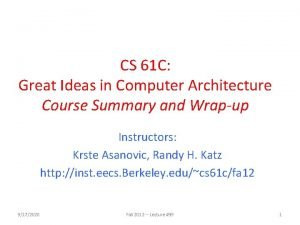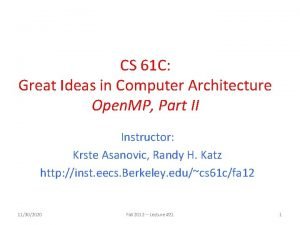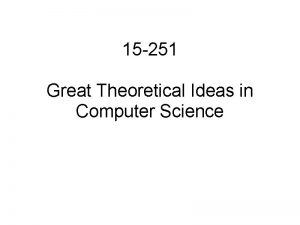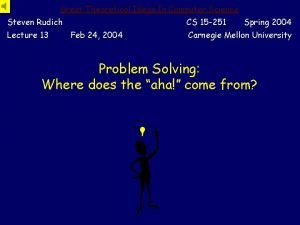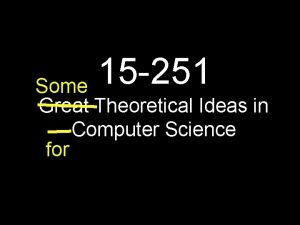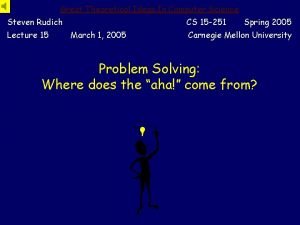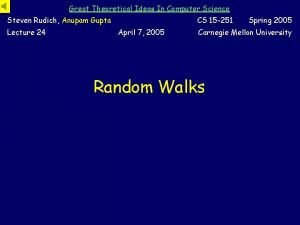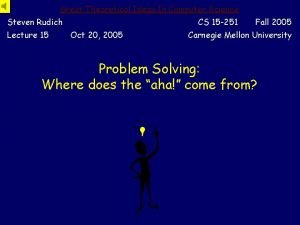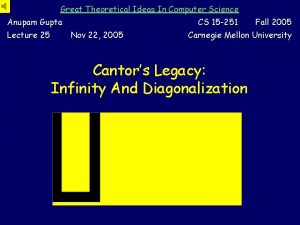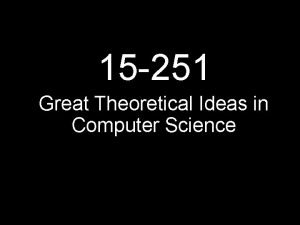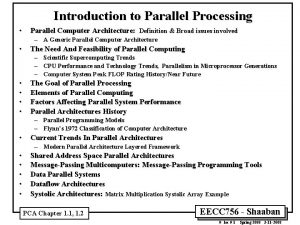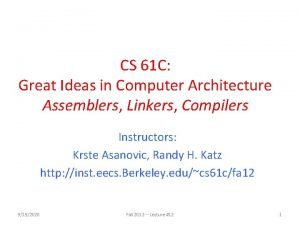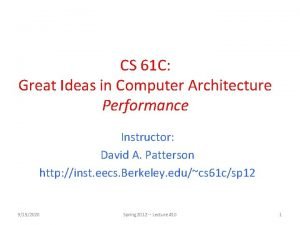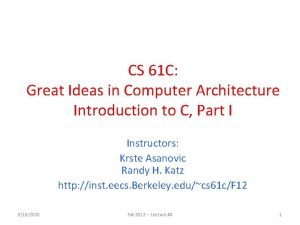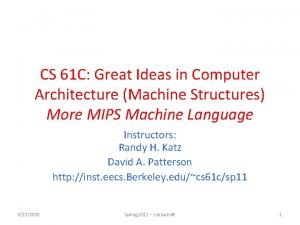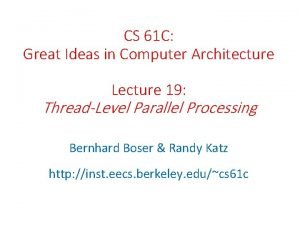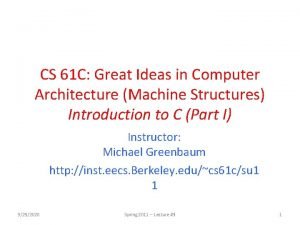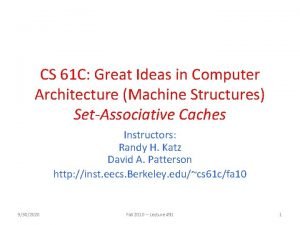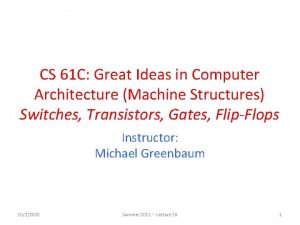CS 61 C Great Ideas in Computer Architecture























































- Slides: 55

CS 61 C: Great Ideas in Computer Architecture Caches Instructors: Randy H. Katz http: //inst. eecs. Berkeley. edu/~cs 61 c/fa 13 11/30/2020 Fall 2013 -- Lecture #12 1

New-School Machine Structures (It’s a bit more complicated!) Software • Parallel Requests Assigned to computer e. g. , Search “Katz” • Parallel Threads Assigned to core e. g. , Lookup, Ads Hardware Harness Parallelism & Achieve High Performance Smart Phone Warehouse Scale Computer • Parallel Instructions >1 instruction @ one time e. g. , 5 pipelined instructions • Parallel Data >1 data item @ one time e. g. , Add of 4 pairs of words • Hardware descriptions All gates @ one time • Programming Languages 11/30/2020 … Core Memory Core (Cache) Input/Output Instruction Unit(s) Today’s Lecture Core Functional Unit(s) A 0+B 0 A 1+B 1 A 2+B 2 A 3+B 3 Cache Memory Logic Gates Fall 2013 -- Lecture #12 2

Agenda • • Review Direct Mapped Cache Administrivia Write Policy and AMAT Technology Break Multiple Cache Levels And in Conclusion, … 11/30/2020 Fall 2013 -- Lecture #12 3

Agenda • • Review Direct Mapped Cache Administrivia Write Policy and AMAT Technology Break Multilevel Caches And in Conclusion, … 11/30/2020 Fall 2013 -- Lecture #12 4

Review: Memory Hierarchy Processor Inner Levels in memory hierarchy Outer Level 1 Level 2 Increasing distance from processor, decreasing speed Level 3. . . Level n Size of memory at each level 11/30/2020 As we move to outer levels the latency goes up and price per bit goes down. Why? Fall 2013 -- Lecture #12 5

Review: Cache Philosophy • Principle of Locality: Programs access small portion of address space at any instant of time – Temporal Locality (locality in time) – Spatial Locality (locality in space) • Programmer-invisible hardware mechanism to give illusion of speed of fastest memory with size of largest memory 11/30/2020 Fall 2013 -- Lecture #12 6

Anatomy of a 16 Byte Cache, 4 Byte Block • Operations: 32 -bit Address 1. Cache Hit 2. Cache Miss 3. Refill cache from memory • Cache needs Address Tags to decide if Processor Address is a Cache Hit or Cache Miss – Compares all 4 tags 11/30/2020 Processor 252 12 1022 131 2041 99 7 20 32 -bit Address Fall 2013 -- Lecture #11 32 -bit Data Cache 32 -bit Data Memory 8

Anatomy of a 32 B Cache, 8 B Block Processor • Blocks must be aligned in 32 -bit pairs, otherwise could get Address Data same word twice in cache Tags only have even 252 12 numbered words 99 1022 42 130 Last 3 bits of address 1947 2040 always 000 two Cache Tags, comparators can be 32 -bit narrower Address Data • Can get hit for either word Memory in block 11/30/2020 Fall 2013 -- Lecture #11 -10 1000 7 20 9

Hardware Cost of Cache • Need to compare 32 -bit every tag to the Address Processor address • Comparators are Tag Set 0 expensive • Optimization: 2 sets Set 1 Tag => ½ comparators • 1 Address bit selects 32 -bit which set Address 11/30/2020 Fall 2013 -- Lecture #12 Processor 32 -bit Data Cache 32 -bit Data Memory 1010

Processor Address Fields used by Cache Controller • Block Offset: Byte address within block • Set Index: Selects which set • Tag: Remaining portion of processor address Processor Address (32 -bits total) Tag Set Index Block offset • Size of Index = log 2 (number of sets) • Size of Tag = Address size – Size of Index – log 2 (number of bytes/block) 11/30/2020 Fall 2013 -- Lecture #12 11

What is Limit to # of Sets? • Can save more comparators if have more than 2 sets • Limit: As Many Sets as Cache Blocks – only needs one comparator! • Called “Direct-Mapped” Design Index Block offset Tag 11/30/2020 Fall 2013 -- Lecture #12 12

One More Detail: Valid Bit • When start a new program, cache does not have valid information for this program • Need an indicator whether this tag entry is valid for this program • Add a “valid bit” to the cache tag entry – 0 => cache miss, even if by chance, address = tag – 1 => cache hit, if processor address = tag 11/30/2020 Fall 2013 -- Lecture #12 13

Agenda • • Review Direct Mapped Cache Administrivia Write Policy and AMAT Technology Break Multilevel Caches And in Conclusion, … 11/30/2020 Fall 2013 -- Lecture #12 14

Direct-Mapped Cache Example • One word blocks, cache size = 1 K words (or 4 KB) 31 30 Hit Valid bit ensures something useful in cache for this index Compare Tag with upper part of Address to see if a Hit 11/30/2020 . . . 13 12 11 Tag 20 Index Valid Tag . . . Block offset 2 1 0 10 Data 0 1 2. . . 1021 1022 1023 32 20 Read data from cache instead of memory if a Hit Comparator What kind of locality are we taking advantage of? Fall 2013 -- Lecture #12 15

Cache Terms • Hit rate: fraction of access that hit in the cache • Miss rate: 1 – Hit rate • Miss penalty: time to replace a block from lower level in memory hierarchy to cache • Hit time: time to access cache memory (including tag comparison) • Abbreviation: “$” = cache (A Berkeley innovation!) 11/30/2020 Fall 2013 -- Lecture #12 16

Mapping a 6 -bit Memory Address 5 4 3 Mem Block Within $ Block Tag • • • 2 1 Block Within $ Index 0 Byte Offset Within Block (e. g. , Word) In example, block size is 4 bytes/1 word (it could be multi-word) Memory and cache blocks are the same size, unit of transfer between memory and cache # Memory blocks >> # Cache blocks – 16 Memory blocks/16 words/64 bytes/6 bits to address all bytes – 4 Cache blocks, 4 bytes (1 word) per block – 4 Memory blocks map to each cache block • • • Byte within block: low order two bits, ignore! (nothing smaller than a block) Memory block to cache block, aka index: middle two bits Which memory block is in a given cache block, aka tag: top two bits 11/30/2020 Fall 2013 -- Lecture #12 17

Caching: A Simple First Example Cache Index Valid Tag Data 00 01 10 11 Q: Is the memory block in cache? Compare the cache tag to the high-order 2 memory address bits to tell if the memory block is in the cache (provided valid bit is set) 11/30/2020 Main Memory 0000 xx One word blocks 0001 xx Two low order bits (xx) 0010 xx define the byte in the 0011 xx block (32 b words) 0100 xx 0101 xx 0110 xx 0111 xx Q: Where in the cache is 1000 xx the mem block? 1001 xx 1010 xx Use next 2 low-order 1011 xx memory address bits – 1100 xx the index – to determine 1101 xx which cache block (i. e. , 1110 xx modulo the number of 1111 xx blocks in the cache) Fall 2013 -- Lecture #12 19

Multiword-Block Direct-Mapped Cache • Four words/block, cache size = 1 K words Hit 31 30. . . Tag Byte offset 13 12 11. . . 4 3 2 1 0 20 Index Data Block offset 8 Data Index Valid Tag 0 1 2. . . 253 254 255 20 32 11/30/2020 What kind of locality are we taking advantage of? Fall 2013 -- Lecture #12 20

Cache Names for Each Organization • “Fully Associative”: Block can go anywhere – First design in lecture – Note: No Index field, but 1 comparator/block • “Direct Mapped”: Block goes one place – Note: Only 1 comparator – Number of sets = number blocks • “N-way Set Associative”: N places for a block – Number of sets = number of blocks / N – Fully Associative: N = number of blocks – Direct Mapped: N = 1 11/30/2020 Fall 2013 -- Lecture #12 21

Range of Set-Associative Caches • For a fixed-size cache, each increase by a factor of 2 in associativity doubles the number of blocks per set (i. e. , the number of “ways”) and halves the number of sets – • Decreases the size of the index by 1 bit and increases the size of the tag by 1 bit More Associativity (more ways) Tag Index Block offset Note: IBM persists in calling sets “ways” and ways “sets”. They’re wrong. 11/30/2020 Fall 2013 -- Lecture #12 22

For S sets, N ways, B blocks, which statements hold? A) The cache has B tags B) The cache needs N comparators C) B = N x S D) Size of Index = Log 2(S) ☐ A only ☐ A and B only ☐ A, B, and C only ☐ All four statements are true 23

For S sets, N ways, B blocks, which statements hold? A) The cache has B tags B) The cache needs N comparators C) B = N x S D) Size of Index = Log 2(S) ☐ A only ☐ A and B only ☐ A, B, and C only ☐ All four statements are true 24

Agenda • • Review Direct Mapped Cache Administrivia Write Policy and AMAT Technology Break Multilevel Caches And in Conclusion, … 11/30/2020 Fall 2013 -- Lecture #12 25

Administrivia • Midterm One Week from Thursday (17 October) – 6 -9 PM in three different rooms: • 1 Pimentel • 10 Evans • 155 Dwinelle – TA-led review session Saturday, 2 -5 PM, Room 155 Dwinelle – (Additional HKN Review on Sunday) 11/30/2020 • Topics: – Cloud Computing and Warehouse Scale Computers – C Programming – MIPS Assembly/Machine Language and Conventions – Compilers and Loaders – Number Representations – Memory Hierarchy and Caches – Parallelism (Request and Data-Level Parallelism) – Labs and Projects Fall 2013 -- Lecture #12 26

CS 61 c in the News 11/30/2020 Fall 2013 -- Lecture #12 27

Agenda • • Review Direct Mapped Cache Administrivia Write Policy Technology Break AMAT And in Conclusion, … 11/30/2020 Fall 2013 -- Lecture #12 28

Handling Stores with Write-Through • Store instructions write to memory, changing values • Need to make sure cache and memory have same values on writes: 2 policies 1) Write-Through Policy: write cache and write through the cache to memory – Every write eventually gets to memory – Too slow, so include Write Buffer to allow processor to continue once data in Buffer – Buffer updates memory in parallel to processor 11/30/2020 Fall 2013 -- Lecture #12 29

Write-Through Cache • Write both values in cache and in memory • Write buffer stops CPU from stalling if memory cannot keep up • Write buffer may have multiple entries to absorb bursts of writes • What if store misses in cache? 11/30/2020 Processor 32 -bit Address 32 -bit Data Cache 252 12 1022 131 2041 99 7 32 -bit Address Fall 2013 -- Lecture #12 Write Buffer Addr Data 20 32 -bit Data Memory 30

Handling Stores with Write-Back 2) Write-Back Policy: write only to cache and then write cache block back to memory when evict block from cache – Writes collected in cache, only single write to memory per block – Include bit to see if wrote to block or not, and then only write back if bit is set • Called “Dirty” bit (writing makes it “dirty”) 11/30/2020 Fall 2013 -- Lecture #12 31

Write-Back Cache • Store/cache hit, write data in cache only & set dirty bit Processor 32 -bit Address – Memory has stale value • Store/cache miss, read data from memory, then update and set dirty bit 252 1022 131 2041 – “Write-allocate” policy • Load/cache hit, use value from cache • On any miss, write back evicted block, only if dirty. Update cache with new block and clear dirty bit. 11/30/2020 Cache 32 -bit Address Fall 2013 -- Lecture #12 Dirty Bits 32 -bit Data D D 12 99 7 20 32 -bit Data Memory 32

Write-Through vs. Write-Back • Write-Through: • Write-Back – Simpler control logic – More predictable timing simplifies processor control logic – Easier to make reliable, since memory always has copy of data 11/30/2020 – More complex control logic – More variable timing (0, 1, 2 memory accesses per cache access) – Usually reduces write traffic – Harder to make reliable, sometimes cache has only copy of data Fall 2013 -- Lecture #12 33

Average Memory Access Time (AMAT) • Average Memory Access Time (AMAT) is the average to access memory considering both hits and misses in the cache AMAT = Time for a hit + Miss rate x Miss penalty 11/30/2020 Fall 2013 -- Lecture #12 34

Average Memory Access Time (AMAT) is the average to access memory considering both hits and misses AMAT = Time for a hit + Miss rate x Miss penalty Given a 200 psec clock, a miss penalty of 50 clock cycles, a miss rate of 0. 02 misses per instruction and a cache hit time of 1 clock cycle, what is AMAT? ☐ ≤ 200 psec ☐ 400 psec ☐ 600 psec ☐ ≥ 800 psec 35

Average Memory Access Time (AMAT) is the average to access memory considering both hits and misses AMAT = Time for a hit + Miss rate x Miss penalty Given a 200 psec clock, a miss penalty of 50 clock cycles, a miss rate of 0. 02 misses per instruction and a cache hit time of 1 clock cycle, what is AMAT? ☐ ≤ 200 psec ☐ 400 psec ☐ 600 psec ☐ ≥ 800 psec 36

Average Memory Access Time (AMAT) • Average Memory Access Time (AMAT) is the average to access memory considering both hits and misses AMAT = Time for a hit + Miss rate x Miss penalty • What is the AMAT for a processor with a 200 psec clock, a miss penalty of 50 clock cycles, a miss rate of 0. 02 misses per instruction and a cache access time of 1 clock cycle? 1 + 0. 02 x 50 = 2 clock cycles Or 2 x 200 = 400 psecs 11/30/2020 Fall 2013 -- Lecture #12 37

Average Memory Access Time (AMAT) • Average Memory Access Time (AMAT) is the average to access memory considering both hits and misses AMAT = Time for a hit + Miss rate x Miss penalty • How calculate if separate instruction and data caches? 11/30/2020 Fall 2013 -- Lecture #12 38

Impact of Cache on CPI • Assume cache hit time included in normal CPU execution time, then CPU time = Instruction Count (IC) × Cycles Per Instruction (CPI) × Cycle Time (CT) = IC × (CPIideal + CPImiss) × CT CPIstalls • A simple model for cache miss impact on CPImiss= accesses/instruction × miss rate × miss penalty 11/30/2020 Fall 2013 -- Lecture #12 39

Impacts of Cache Performance • Relative $ penalty increases as processor performance improves (faster clock rate and/or lower CPI) – When calculating CPIstalls, cache miss penalty is measured in processor clock cycles needed to handle a miss – Lower the CPIideal, more pronounced impact of stalls • Processor with a CPIideal of 2, a 100 -cycle miss penalty, 36% load/store instr’s, and 2% I$ and 4% D$ miss rates – CPImiss= 2% × 100 + 36% × 4% × 100 = 3. 44 – So CPIstalls = 2 + 3. 44 = 5. 44 – More than twice the CPIideal ! • What if the CPIideal is reduced to 1? • What if the D$ miss rate went up by 1%? 11/30/2020 Fall 2013 -- Lecture #12 40

Impact of Larger Cache on AMAT? • 1) Lower Miss rate • 2) Longer Access time (Hit time): smaller is faster – Increase in hit time will likely add another stage to the pipeline • At some point, increase in hit time for a larger cache may overcome the improvement in hit rate, yielding a decrease in performance • Computer architects expend considerable effort optimizing organization of cache hierarchy – big impact on performance and power! 11/30/2020 Fall 2013 -- Lecture #12 41

How to Reduce Miss Penalty? • Could there be locality on misses from a cache? • Use multiple cache levels! • With Moore’s Law, more room on die for bigger L 1 caches and for second-level (L 2) cache • And in some cases even an L 3 cache! • IBM mainframes have ~1 GB L 4 cache off-chip. 11/30/2020 Fall 2013 -- Lecture #12 42

Agenda • • Review Direct Mapped Cache Administrivia Write Policy and AMT Technology Break Multilevel Caches And in Conclusion, … 11/30/2020 Fall 2013 -- Lecture #12 43

Agenda • • Review Direct Mapped Cache Administrivia Write Policy and AMAT Technology Break Multilevel Caches And in Conclusion, … 11/30/2020 Fall 2013 -- Lecture #12 44

Multiple Cache Levels • E. g. , CPIideal of 2, 100 cycle miss penalty (to main memory), 25 cycle miss penalty (to L 2$), 36% load/stores, a 2% (4%) L 1 I$ (D$) miss rate, add a 0. 5% L 2$ miss rate – CPIstalls = 2 + 0. 02× 25 + 0. 36× 0. 04× 25 + 0. 005× 100 + 0. 36× 0. 005× 100 = 3. 54 (vs. 5. 44 with no L 2$) 11/30/2020 Fall 2013 -- Lecture #12 45

Local vs. Global Miss Rates • Local miss rate – the fraction of references to one level of a cache that miss • Local Miss rate L 2$ = $L 2 Misses / L 1$ Misses • Global miss rate – the fraction of references that miss in all levels of a multilevel cache • L 2$ local miss rate >> than the global miss rate • Often as high as 50% local miss rate – still useful? 11/30/2020 Fall 2013 -- Lecture #12 46

For L 1 cache AMAT = Time for a hit + Miss rate x Miss penalty What is AMAT for system with L 1 and L 2 cache (L 2 miss rate is local miss rate)? ☐ ☐ Time for L 2 hit + L 2 Miss rate x L 2 Miss penalty Time for L 1 hit + L 1 Miss rate x L 2 Miss rate x Miss penalty Time for L 1 hit + L 1 Miss rate x (Time for L 2 hit + L 2 Miss rate x Miss Penalty) Time for L 1 hit + L 1 Miss rate x Miss penalty + Time for L 2 hit + L 2 Miss rate x Miss penalty 47

For L 1 cache AMAT = Time for a hit + Miss rate x Miss penalty What is AMAT for system with L 1 and L 2 cache (L 2 miss rate is local miss rate)? ☐ ☐ Time for L 2 hit + L 2 Miss rate x L 2 Miss penalty Time for L 1 hit + L 1 Miss rate x L 2 Miss rate x Miss penalty Time for L 1 hit + L 1 Miss rate x (Time for L 2 hit + L 2 Miss rate x Miss Penalty) Time for L 1 hit + L 1 Miss rate x Miss penalty + Time for L 2 hit + L 2 Miss rate x Miss penalty 48

Local vs. Global Miss Rates • Local miss rate – the fraction of references to one level of a cache that miss • Local Miss rate L 2$ = $L 2 Misses / L 1$ Misses • Global miss rate – the fraction of references that miss in all levels of a multilevel cache • L 2$ local miss rate >> than the global miss rate • Global Miss rate = L 2$ Misses / Total Accesses = L 2$ Misses / L 1$ Misses x L 1$ Misses / Total Accesses = Local Miss rate L 2$ x Local Miss rate L 1$ • AMAT = Time for a hit + Miss rate x Miss penalty • AMAT = Time for a L 1$ hit + (local) Miss rate. L 1$ x (Time for a L 2$ hit + (local) Miss rate L 2$ x L 2$ Miss penalty) 11/30/2020 Fall 2013 -- Lecture #12 49

Improving Cache Performance (1 of 3) AMAT = Hit Time + Miss rate x Miss penalty 1. Reduce the time to hit in the cache – Smaller cache 2. Reduce the miss rate – Bigger cache – Larger blocks (16 to 64 bytes typical) – (Later in semester: More flexible placement by increasing associativity) 11/30/2020 Fall 2013 -- Lecture #12 50

Improving Cache Performance (2 of 3) 3. Reduce the miss penalty – Smaller blocks – Use multiple cache levels • L 2 cache size not tied to processor clock rate – Higher DRAM memory bandwidth (faster DRAMs) – Use a write buffer to hold dirty blocks being replaced so don’t have to wait for the write to complete before reading 11/30/2020 Fall 2013 -- Lecture #12 51

The Cache Design Space (3 of 3) • Several interacting dimensions – – – Cache Size Cache size Block size Write-through vs. write-back Write allocation (Later Associativity) (Later Replacement policy) (Associativity) Block Size • Optimal choice is a compromise – Depends on access characteristics • Workload • Use (I-cache, D-cache) – Depends on technology / cost • Simplicity often wins 11/30/2020 Bad Good Factor A Less Fall 2013 -- Lecture #12 Factor B More 52

Multilevel Cache Design Considerations • Different design considerations for L 1$ and L 2$ – L 1$ focuses on minimizing hit time for shorter clock cycle: Smaller $ with smaller block sizes – L 2$(s) focus on reducing miss rate to reduce penalty of long main memory access times: Larger $ with larger block sizes • Miss penalty of L 1$ is significantly reduced by presence of L 2$, so can be smaller/faster but with higher miss rate • For the L 2$, hit time is less important than miss rate – L 2$ hit time determines L 1$’s miss penalty 11/30/2020 Fall 2013 -- Lecture #12 53

11/30/2020 Fall 2013 -- Lecture #12 54

CPI/Miss Rates/DRAM Access Spec. Int 2006 Data Only 11/30/2020 Data Only Fall 2013 -- Lecture #12 Instructions and Data 55

Typical Memory Hierarchy On-Chip Components Control Reg. File Instr Data Cache ½’s 10’s 100’s 10 K’s M’s G’s Datapath Speed (cycles): Size (bytes): Cost/bit: Second Level Cache (SRAM) Main Memory (DRAM) highest Secondary Memory (Disk Or Flash) 1, 000’s T’s lowest • Principle of locality + memory hierarchy presents programmer with ≈ as much memory as is available in the cheapest technology at the ≈ speed offered by the fastest technology 11/30/2020 Fall 2013 -- Lecture #12 56

And in Conclusion, … • Great Ideas: Principle of Locality and Memory Hierarchy • Cache – copy of data lower level in memory hierarchy • Direct Mapped to find block in cache using Tag field and Valid bit for Hit • AMAT balances Hit time, Miss rate, Miss penalty • Larger caches reduce Miss rate via Temporal and Spatial Locality, but can increase Hit time • Multilevel caches reduce the Miss penalty • Write-through versus write-back caches 11/30/2020 Fall 2013 -- Lecture #12 57
 Eight ideas in computer architecture
Eight ideas in computer architecture Task level parallelism
Task level parallelism Cs61c
Cs61c 8 great ideas in computer architecture
8 great ideas in computer architecture Great theoretical ideas in computer science
Great theoretical ideas in computer science Great ideas in theoretical computer science
Great ideas in theoretical computer science Great theoretical ideas in computer science
Great theoretical ideas in computer science Great ideas in computer science
Great ideas in computer science Cmu 15251
Cmu 15251 Great theoretical ideas in computer science
Great theoretical ideas in computer science Great theoretical ideas in computer science
Great theoretical ideas in computer science Great theoretical ideas in computer science
Great theoretical ideas in computer science Great theoretical ideas in computer science
Great theoretical ideas in computer science Great theoretical ideas in computer science
Great theoretical ideas in computer science Great theoretical ideas in computer science
Great theoretical ideas in computer science 3 bus architecture
3 bus architecture Computer architecture vs computer organization
Computer architecture vs computer organization Basic computer organization and design
Basic computer organization and design Ideas have consequences bad ideas have victims
Ideas have consequences bad ideas have victims Ideas principales e ideas secundarias
Ideas principales e ideas secundarias Unit 4 great ideas
Unit 4 great ideas Turning great strategy into great performance
Turning great strategy into great performance Great faces
Great faces Responsible leadership meaning
Responsible leadership meaning Hammerhead shark versus great white shark
Hammerhead shark versus great white shark Did alexander the great deserve to be called great
Did alexander the great deserve to be called great Frederick the great enlightened despot
Frederick the great enlightened despot With great expectations comes great responsibility
With great expectations comes great responsibility A great deal vs a great many
A great deal vs a great many With great power comes great responsibility batman
With great power comes great responsibility batman Does alexander deserve to be called the great
Does alexander deserve to be called the great Great is thy faithfulness o lord my father
Great is thy faithfulness o lord my father Architecture business cycle activities
Architecture business cycle activities Call and return architecture in software architecture
Call and return architecture in software architecture Integral vs modular architecture
Integral vs modular architecture Slot modular architecture
Slot modular architecture Computer organization and architecture 10th solution
Computer organization and architecture 10th solution Fast desktop for architecture software
Fast desktop for architecture software Iit kharagpur virtual lab coa
Iit kharagpur virtual lab coa Introduction to computer organization and architecture
Introduction to computer organization and architecture Timing and control in computer architecture
Timing and control in computer architecture Evolution of computer architecture
Evolution of computer architecture Dma controller in computer architecture
Dma controller in computer architecture Fp adder
Fp adder Absolute addressing mode in computer architecture
Absolute addressing mode in computer architecture Chordal ring
Chordal ring Smt computer architecture
Smt computer architecture Mips div
Mips div Collision vector in pipelining
Collision vector in pipelining Instruction format in computer architecture
Instruction format in computer architecture Nanoprogram
Nanoprogram Microprogram sequencer is used in
Microprogram sequencer is used in Memory system
Memory system Dram memory mapping
Dram memory mapping Non linear pipeline processors
Non linear pipeline processors Computer architecture definition
Computer architecture definition

